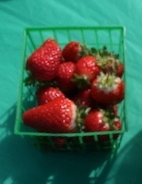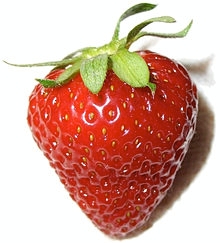There are two types of strawberries: day-neutral varieties, also called ever bearers, and short-day types.
Ever-bearing plants are not affected by day length and have their highest production from spring through fall. Short-day types produce from fall through early spring when days are shorter. In our area, ever bearers are generally considered synonymous with day neutrals.
Your strawberry plants will need at least eight hours of full sun each day to produce well. Strawberries grow best in loamy or sandy soils. Before planting, prepare the soil by incorporating two to three inches of compost or other organic matter to a depth of at least 12 inches. Organic matter improves nutrient availability as well as the soil's structure and water-holding capacity.
Dig in some balanced fertilizer as well. Strawberries may still need to be fed several times during the growing season. Poor vigor or light green leaves tell you that it's time to fertilize. Heavy clay soil hampers strawberry growth and vigor and encourages disease, but you can succeed with clay soil if it is well drained. If possible, plant strawberries in raised beds to improve soil drainage and aeration.
When planting, remove any dead leaves, spread the roots out in the planting hole, and firm the soil around the plant. The crown of the plant — the area between the roots and the leaf stems — should be even with or slightly above ground level. Water the transplants well. Strawberry plants have shallow roots and need to be kept moist during the growing season. Use drip irrigation to keep moisture away from the fruit, minimizing fruit rot. Strawberries don't compete well with weeds, so be a vigilant weeder to extend the life of your beds.
Think about your strawberry bed as a temporary structure. Relocate plants after three to five years to prevent buildup of soil-borne pathogens. Avoid planting them in areas where you have recently grown other members of the Solanaceae family, such as peppers, tomatoes, potatoes, eggplant and okra. They are all subject to the same soil-borne diseases.
Napa County Master Gardeners recently completed a year-long field trial of three markedly different strawberry varieties. We grew two day-neutral varieties, Albion and Quinault, and one short-day variety, Sequoia. Trial participants planted bare-root seedlings in January. Some gardeners planted in containers, which work well because of the plants' small root systems.
Following common practice, we removed runners the first year to strengthen the mother plants. Some gardeners also removed the first flush of blossoms and consequently harvested a meager amount of Sequoia berries, if any. Most of us used straw mulch to retain soil moisture and keep fruit off the ground, away from earwigs, sow bugs, snails and slugs.
Birds pecking at ripe fruit were among the most annoying pests; some gardeners used netting to control them.
Fruit production varied. The Sequoia plants produced some huge, sweet berries but finished production before hot weather began, leaving us with the impression that its growing season was too short.
The Quinault plants yielded smaller, very soft fruit that needed to be eaten almost immediately. A few growers complained about having to throw away so many Quinault berries because they were too soft.
Albion berries were by far the best producers, yielding large, sweet, conical fruit on upright stems. Currently, the Albion is one of the most popular strawberry varieties in California. It was developed at the UC Davis and introduced only a few years ago. Photo of some of our harvest of Albion strawberries grown at our demonstration garden.

Our group kept yield records through Oct. 31. However, several gardeners, as well as their children and grandchildren, succumbed to temptation and ate some of the juicy crop before it had a chance to be weighed.
Consequently, our results are not rigorously scientific.
Roughly speaking, Albion berries accounted for 67 percent of the total yield, Quinault berries 25 percent and Sequoia berries 8 percent. Most of the participants intend to keep their plants going for another year.
For more information on growing strawberries and strawberry pest information see the UC integrated Pest Management website http://www.ipm.ucdavis.edu/PMG/GARDEN/FRUIT/strawberries.html
Napa County Master Gardeners ( http://cenapa.ucdavis.edu) are available to answer gardening questions Monday, Wednesday and Friday, 9 a.m. to noon, at the UC Cooperative Extension office, 1710 Soscol Ave., Suite 4, Napa, 253-4221.
